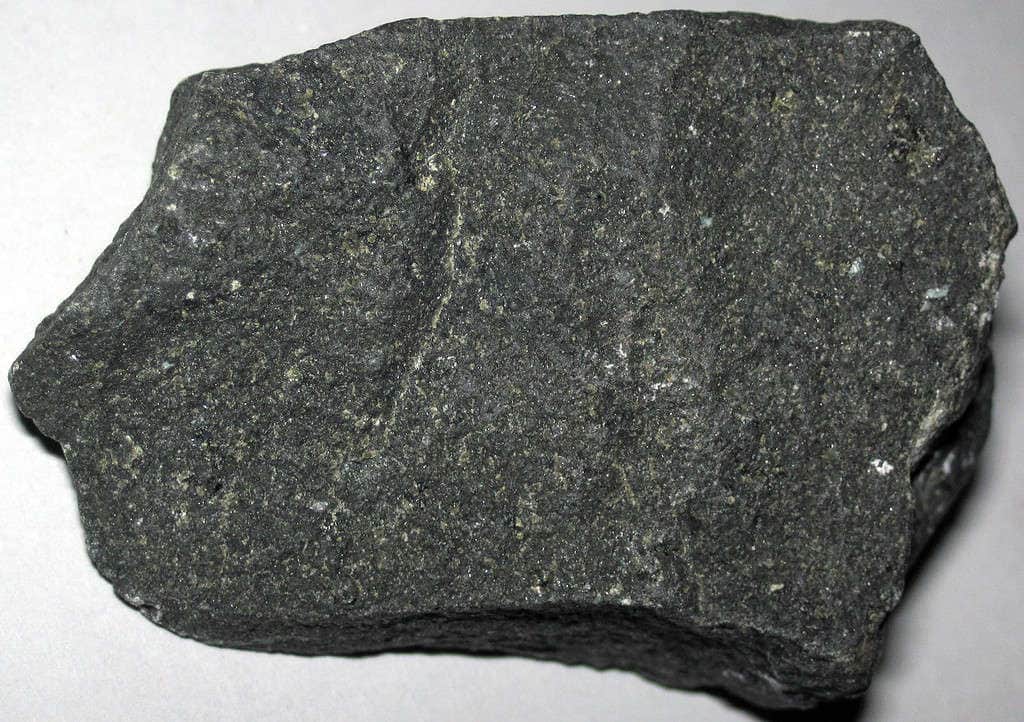
What is Basalt?
Basalt is a fine-grained, extrusive igneous rock predominantly formed from the rapid cooling of mafic lava, which is low in silica and rich in magnesium and iron.
In geology, “extrusive” refers to igneous rocks that are formed by the cooling and solidification of magma at the Earth’s surface. This contrasts with intrusive igneous rocks like granite, which cool slowly beneath the Earth’s surface and generally have a coarser texture.This process happens when magma erupts onto the surface from a volcano or through a fissure, where it cools quickly due to exposure to the cooler air or water. As a result, extrusive rocks usually have a fine-grained or aphanitic texture, meaning their mineral grains are so small that they are often not visible to the naked eye. Common examples of extrusive igneous rocks include basalt and obsidian.
Basalt isn’t just the also significant in the geology of other planetary bodies in our Solar System.
The Formation and Composition of Basalt
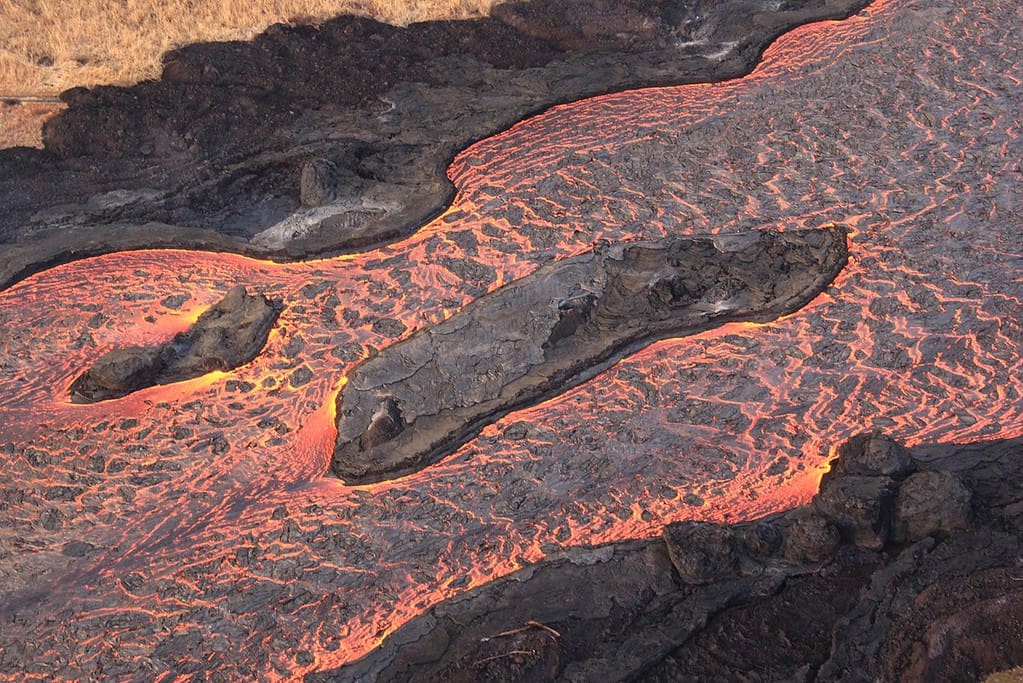
Basalt forms when lava reaches the Earth’s surface at a volcano or mid-ocean ridge. The lava originates from the upper mantle, typically at depths of up to about 50-100 kilometers. The high pressure and temperature conditions in the mantle produce molten material that, when released to the surface, cools rapidly to form basalt. This process is particularly common at divergent plate boundaries, hot spots, and oceanic hotspots.
Basalt primarily forms in three key geological settings:
- Mid-Ocean Ridges: Here, basaltic lava emerges as the oceanic plates diverge, creating new oceanic crust. The process, known as decompression melting, involves the upward movement of the mantle material, decreasing pressure, and subsequently melting to form magma.
- Hotspots: These are plumes of hot mantle material rising towards the Earth’s surface, independent of plate boundaries. As this plume reaches shallower depths, pressure decreases, leading to partial melting of the mantle and the production of basaltic magma. Iconic examples include the Hawaiian Islands and Iceland.
- Continental Rifts: In these zones, the continental crust is stretched and thinned, reducing pressure on the underlying mantle. This process can result in the formation of basalt through similar mechanisms as at mid-ocean ridges.
Chemical composition
Basalt’s composition is primarily mafic, meaning it’s rich in magnesium and iron while being low in silica. Key components include:
- Silica (SiO₂): Ranges from 45% to 52%, significantly lower than in felsic rocks like granite.
- Iron (Fe) and Magnesium (Mg): These elements give basalt its characteristic dark color.
- Calcium (Ca), Aluminum (Al), and Sodium (Na): Present in lesser amounts, contributing to various mineral formations within the rock.
Mineral Content
Common minerals in basalt include:
- Plagioclase Feldspar: Often the most abundant mineral in basalt, varying in composition from calcium-rich to sodium-rich.
- Pyroxene: Typically augite, providing much of the iron and magnesium content.
- Olivine: Common in some basalts, particularly those from hotter mantle sources.
- Amphibole and Quartz: Less common, but may be present in some varieties.
Plate tectonics
The formation of basalt is a key process in understanding plate tectonics and the recycling of material in the Earth’s crust. The creation and distribution of basaltic crust at mid-ocean ridges drive seafloor spreading, a fundamental component of plate tectonic theory.
Types of Basalt
Basalt, despite its uniform appearance, has several distinct types, each telling a unique story of its origins and geological history. Basalt varies in type mainly based on its mineral content and texture.
Tholeiitic Basalt
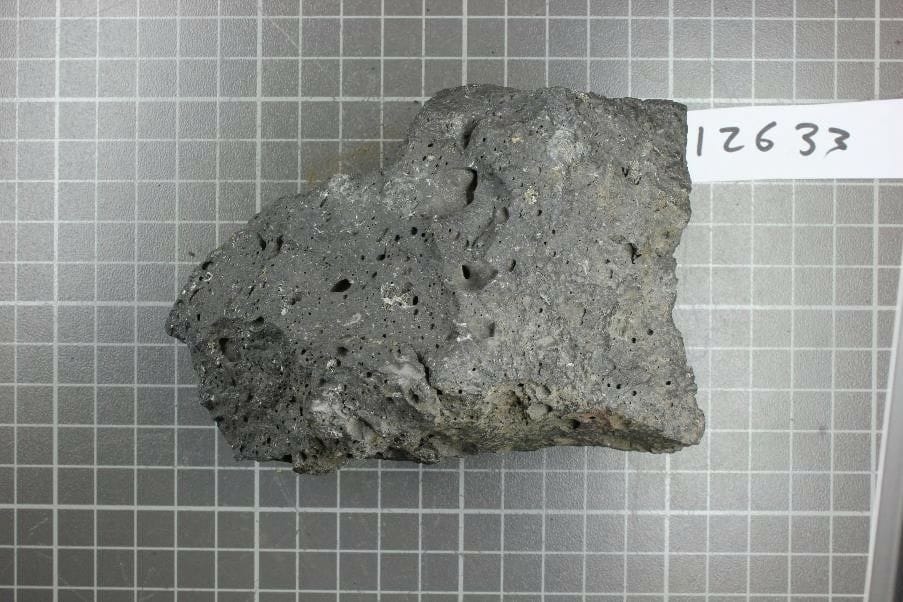
- Characteristics: Tholeiitic basalt is typically rich in iron and magnesium, with low levels of alkali metals and aluminum.
- Formation: Commonly formed at mid-ocean ridges and in continental flood basalt provinces.
- Composition: They often have a composition that is intermediate between olivine tholeiite and quartz tholeiite.
- Location: Prominent examples include the ocean floor basalts and the large oceanic islands like Hawaii.
Alkali Basalt
- Characteristics: Rich in alkali metals and may contain feldspathoids.
- Composition: Alkali basalts have a higher proportion of alkali metals (Na₂O and K₂O) compared to tholeiitic basalts.
- Formation: They are often associated with continental rifting, hotspot volcanism, and oceanic islands’ later stages of volcanic activity.
- Mineralogy: Contains minerals like nepheline, leucite, and olivine, and has a higher content of titanium-enriched augite.
High-Alumina Basalt
- Characteristics: These basalts bridge the gap between tholeiitic and alkali basalts, with higher alumina content.
- Composition: They have more than 17% alumina (Al₂O₃) and are silica-undersaturated.
- Formation: Commonly found in volcanic arcs above subduction zones.
- Mineral Content: Characterized by the absence of olivine in the phenocryst phase and the presence of amphibole or biotite.
Vesicular Basalt
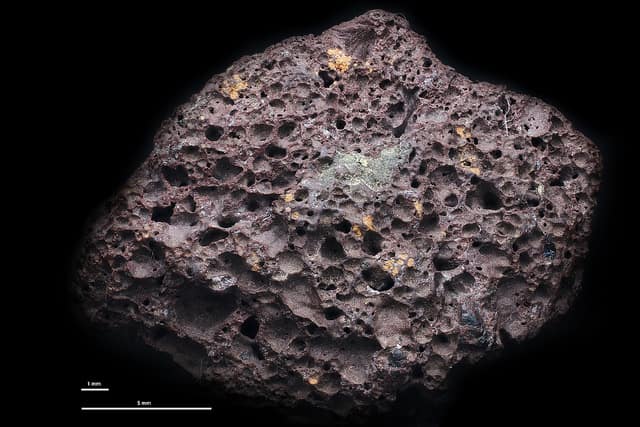
- Texture: Characterized by numerous vesicles (gas bubbles), giving it a porous appearance.
- Formation: Forms from basaltic lava that cools rapidly, trapping gases like water vapor and carbon dioxide.
- Color and Composition: Typically dark (grey to black), composed mainly of pyroxene and plagioclase minerals.
- Geological Context: Common in volcanic areas, indicative of surface or near-surface lava solidification.
Ocean Island Basalts (OIB)
- Characteristics: These basalts are found in oceanic islands and exhibit a range of compositions.
- Formation: They often start as tholeiitic basalts and later transition to alkali basalts.
- Composition: Marked by elevated concentrations of incompatible elements.
- Location: Examples include the Hawaiian and Canary Islands.
Boninite
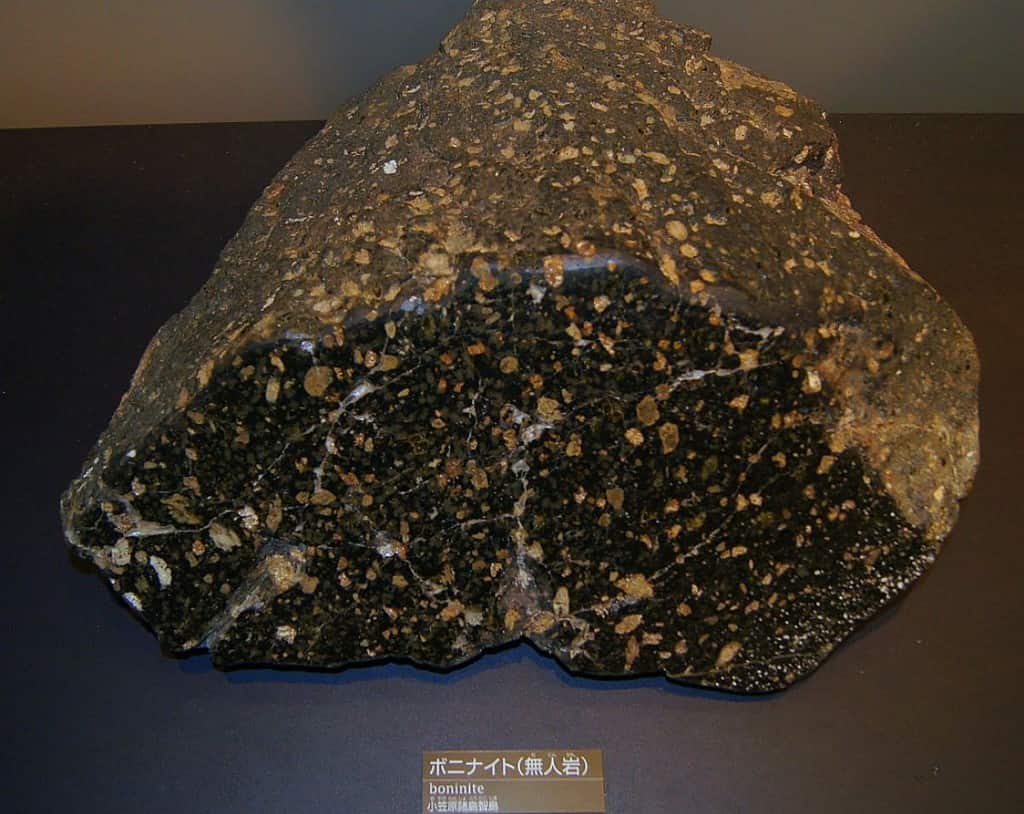
- Characteristics: A high-magnesium form of basalt, distinguished by its low titanium content.
- Formation: Typically erupted in back-arc basins.
- Composition: Contains higher amounts of magnesium and silica and less titanium and iron than typical basalts.
- Mineralogy: Rich in orthopyroxene and clinopyroxene, with a low calcium content.
Transitional Basalt
- Characteristics: Intermediate in composition between tholeiitic and alkali basalts.
- Formation: Common in areas where tectonic settings are changing, such as the transition from a rift to a spreading center.
- Composition: Shows characteristics of both end-member types but doesn’t fit neatly into either category.
Mid-Ocean Ridge Basalt (MORB)
- Characteristics: A subtype of tholeiitic basalt, commonly erupted only at ocean ridges.
- Composition: Characteristically low in incompatible elements and has a relatively flat REE pattern.
- Variants: Includes different types like N-MORB (normal), E-MORB (enriched), and D-MORB (depleted), each reflecting varying degrees of mantle source depletion.
Continental Flood Basalts
- Characteristics: Represent some of the largest basaltic provinces on Earth.
- Formation: Associated with continental rifting and the formation of large igneous provinces.
- Examples: The Deccan Traps in India and the Siberian Traps in Russia are notable examples.
Characteristics of Basalt
Basalt exhibits a variety of characteristics that make it both unique and widely useful. Here are some key attributes:
Color and Appearance
Basalt is primarily recognized by its dark color, ranging from dark gray to black. However, there are color variations. Some basalts can be lighter, particularly those rich in plagioclase, sometimes referred to as leucobasalts. In terms of surface features, basalt may exhibit vesicles (gas bubbles) or a glassy texture, especially when it has rapidly cooled at the Earth’s surface.
Texture
Basalt’s texture is fine-grained due to its rapid cooling at or near the Earth’s surface, resulting in an aphanitic texture where individual mineral grains are not visible to the naked eye. Some basalts contain larger crystals, known as phenocrysts, within a finer-grained matrix, indicating a more complex cooling history.
Density and Hardness
Basalt is denser than many other rocks, typically around 2.9 g/cm³, attributed to its high content of iron and magnesium. It is also relatively hard, capable of scratching glass and steel.
Chemical and Mineral Composition
Basalt is commonly composed of primary minerals such as plagioclase feldspar, pyroxene, and often olivine. It may also include secondary minerals like iron-titanium oxides, such as magnetite and ilmenite. The silica content in basalt is typically low, ranging between 45% to 52%.
Thermal Properties
Basalt has a high melting point, usually above 1,000°C, and a relatively high specific heat capacity, meaning it can store significant amounts of heat.
Magnetic Properties
Certain types of basalt can become strongly magnetized due to their iron-rich composition, a property that has been instrumental in studying the Earth’s past magnetic field orientations.
Vesicular and Amygdaloidal Textures
Vesicular basalt is characterized by the presence of vesicles formed by trapped gas bubbles during the rapid cooling of the lava. Amygdaloidal basalt occurs when these vesicles are later filled with secondary minerals like zeolites, calcite, or quartz.
Weathering Characteristics
Basalt weathers relatively faster than granite but is still considered durable. In humid climates, its iron content can oxidize, giving the rock a reddish or brownish hue over time.
Porosity and Permeability
Vesicular basalts can have high porosity due to the abundance of gas bubbles. The permeability of basalt varies depending on the vesicle connectivity and the degree of fracturing or secondary mineral infill.
Distribution of Basalt
The distribution of basalt can reveal a lot about Earth’s internal processes and tectonic history. Basalt is found in a variety of geological settings:
Oceanic Crust
Basalt forms the bulk of the oceanic crust and is predominantly found at mid-ocean ridges. As tectonic plates diverge at these ridges, basaltic lava rises to fill the gaps, creating new ocean floor. Underwater, basalt forms distinctive pillow-shaped structures due to rapid cooling upon contact with water.
Continental Regions
In continental settings, basalt often appears in large, extensive lava flows known as flood basalts, covering thousands of square kilometers, formed by massive eruptions. Notable examples include the Deccan Traps in India and the Columbia River Basalt Group in the USA.
Volcanic Islands
Basalt is a common rock type in volcanic islands, especially those formed over hotspots like the Hawaiian Islands. These islands typically begin with a phase of tholeiitic basalt, which later transitions to alkali basalts.
Volcanic Arcs
At convergent plate boundaries, where an oceanic plate subducts beneath a continental plate, basalt is formed in the associated volcanic arcs. Basaltic eruptions in these zones contribute to the growth of volcanic mountains and island chains.
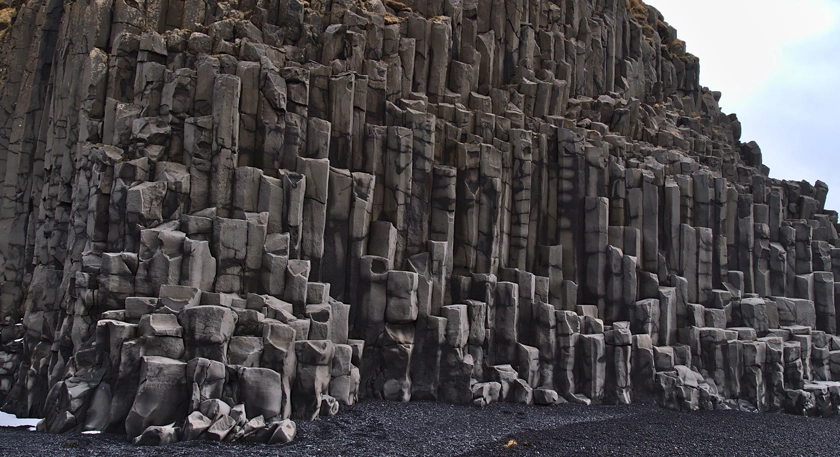
Tectonic Plate Boundaries
Basalt is frequently encountered in rift zones, such as the East African Rift, where tectonic plates are pulling apart. It also plays a crucial role in the process of seafloor spreading at mid-ocean ridges, where it is the primary rock type.
Extraterrestrial Occurrences
The dark plains on the Moon, known as lunar maria, are largely composed of basaltic rock, formed from ancient volcanic eruptions. Basalt is also abundant on the surfaces of Mars and Venus, offering insights into the volcanic history and crustal composition of these planets.
Ancient Basalts
Older basalt formations, heavily metamorphosed over time, are found in the Precambrian shields, providing insight into the early Earth’s crustal development. In ancient terrains known as greenstone belts, basalts are typically altered to green minerals like chlorite and epidote.
How to Identify Basalt
Identifying basalt in the field or in hand samples involves observing several characteristic features. These features help distinguish basalt from other common rock types.
Visual Identification
- Color: Basalt is typically dark gray to black. Variations can occur, but this dark coloration is a reliable first indicator.
- Texture: It has a fine-grained texture, with crystals too small to be discerned by the naked eye. In some cases, basalt may be porphyritic, containing visible larger crystals (phenocrysts) in a fine-grained matrix.
Physical Properties
- Density: Basalt is heavier than most common rocks due to its rich iron and magnesium content. It feels heavier than its size would suggest.
- Hardness: Basalt is hard enough to scratch glass or steel, a characteristic that can be tested with a simple scratch test.
Geological Context
- Location: Knowing where the rock was found can provide vital clues. Basalt is commonly associated with volcanic regions, oceanic crust, and ancient lava flows.
- Associated Rocks: Basalt may be found in association with other volcanic rocks like andesite and rhyolite.
Structural Features
- Vesicles: Presence of vesicles (gas bubbles) can indicate a basaltic origin, especially in rocks that solidified quickly near the Earth’s surface.
- Amygdales: Some basalts, especially those exposed to weathering, contain amygdales, which are former vesicles filled with secondary minerals like calcite or quartz.
Mineral Composition
- Mineral Content: While difficult to discern in fine-grained basalts, the presence of minerals such as plagioclase, pyroxene, and olivine, often in a dark matrix, can be indicative of basalt.
- Magnetism: Some basalts contain magnetic minerals like magnetite. A simple magnet test can sometimes reveal a weak magnetic attraction.
Chemical Tests
- Acid Reaction: Basalt generally does not react with dilute hydrochloric acid, a test that can differentiate it from carbonate rocks.
Weathering Characteristics
- Surface Alteration: Basalt weathers to a reddish-brown color due to iron oxidation. This weathering pattern can help in its identification.
Uses of Basalt

The versatility of basalt in various sectors highlights its importance as a resource. Its applications range from practical uses in construction and industry to artistic and cultural significance, demonstrating the material’s multifaceted value to society.
Construction Industry
In the construction industry, basalt is valued for its durability and resistance to weathering. Crushed basalt is commonly used as an aggregate for road construction and as a base material for concrete. Its strength and density also make basalt suitable for use as railroad ballast, serving as the layer of crushed rock or gravel upon which railway tracks are laid.
Landscaping and Architectural Applications
Basalt’s aesthetic appeal has made it popular in landscaping, utilized for rock gardens, pathways, and decorative stones. In architectural applications, it is used for cladding walls and as paving stones in pedestrian areas, providing both functionality and visual appeal.
Industrial Applications
In industrial settings, basalt is transformed into stone wool when melted and spun into fine threads, an effective material for thermal and acoustic insulation used in buildings and various industries. It also serves as a stable and fine-grained filter media for water purification and sewage treatment.
Art and Sculpture
Basalt’s uniform texture and hardness make it an ideal material for carving detailed sculptures and decorative items, showcasing its versatility in artistic applications. Historically, basalt has been used for various artifacts, including grinding stones, statues, and monuments, indicating its cultural significance.
Carbon Sequestration
Research into carbon sequestration using basalt is ongoing, exploring the rock’s potential to capture carbon dioxide in its pores and eventually mineralize it, offering a promising avenue for environmental conservation and climate change mitigation.
Scientific and Technological Uses
Basalt plays a significant role in geological and planetary science research, aiding in understanding Earth’s crust and the geology of other planets. Its properties are also being explored for use in high-tech applications, such as fiber optics and composite materials, underscoring its importance in the tech industry.
Agricultural Applications
In agriculture, crushed basalt is used to enhance soil quality, adding essential minerals and improving drainage and soil structure, thus contributing to more sustainable and effective farming practices.
Marine Applications
The durability and resistance to erosion of basalt make it an excellent choice for coastal engineering projects, including the construction of breakwaters and groynes, highlighting its utility in protecting and managing shoreline environments.
Facts about Basalt
- Most Common Volcanic Rock: Basalt is the most abundant volcanic rock type on Earth’s surface, accounting for most of the oceanic crust and large parts of the continental volcanic landscapes.
- Covers 70% of Earth’s Surface: Including both oceanic and continental regions, basaltic rocks cover about 70% of the Earth’s surface.
- Fast-Moving Lava: Basaltic lava flows, characterized by their low viscosity, can move rapidly and cover large areas, as witnessed in numerous volcanic eruptions.
- Ancient Uses: Basalt has been used historically for various purposes, including in early writing tablets like the Code of Hammurabi, and in construction by ancient civilizations like the Egyptians and Romans.
- Cultural Artifacts: Many ancient artifacts, including statues, tools, and building materials, were made from basalt due to its durability.
- Carbon Sequestration Potential: Basalt is being researched for its ability to capture and store atmospheric carbon dioxide, offering a potential solution for climate change mitigation.
FAQ about Basalt
What differentiates basalt from other volcanic rocks?
Basalt is distinguished by its fine-grained texture, dark color, and composition rich in iron and magnesium but low in silica. It contrasts with other volcanic rocks like andesite and rhyolite, which have higher silica content and lighter colors.
Can basalt be used in reducing atmospheric CO2?
Yes, basalt has potential in carbon sequestration. Its porous nature and mineral composition allow it to react with CO2, forming stable carbonate minerals. This property is being explored as a means to mitigate climate change by storing atmospheric carbon dioxide.
Is basalt present on all continents?
Yes, basalt is found worldwide. Its distribution is not limited to any specific continent, though the form and context can vary depending on the local geological and tectonic history.
How does basalt relate to the Earth’s tectonic activity?
Basalt is intimately connected to tectonic activities, especially at mid-ocean ridges and hotspots. The formation of new oceanic crust at mid-ocean ridges involves the upwelling and solidification of basaltic magma, making it a key component in the process of seafloor spreading.
What makes basalt suitable for construction and architectural uses?
Basalt’s suitability for construction and architecture stems from its hardness, durability, and resistance to weathering. These properties make it an excellent choice for building materials, road aggregates, and decorative stones.
The exploration of basalt, from its formation and distribution to its diverse applications, highlights its central role in both the natural world and human civilization. This ubiquitous rock, though often overlooked, is a cornerstone in our understanding of planetary geology and a vital resource in various industries.


